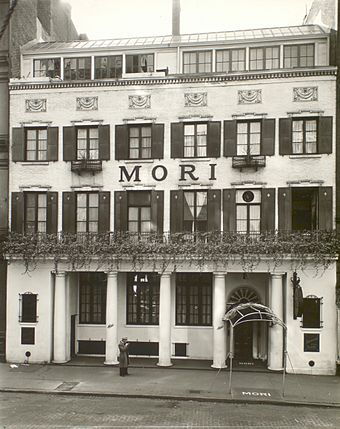Mori (restaurant) facts for kids

Mori's Restaurant (1935)
|
|
| Address | 144 Bleecker Street, New York City, New York |
|---|---|
| Owner | Placido Mori |
| Type | restaurant, art house movie theatre |
| Construction | |
| Built | 1832 |
| Opened | 1883 |
| Renovated | 1883 |
| Closed | 1937 |
| Architect | Raymond Hood |
Mori was a famous Italian restaurant in Greenwich Village, New York City. It opened in 1883 and closed in 1937. The restaurant faced financial problems during the Great Depression. After it closed, the building became the Bleecker Street Cinema.
History of Mori's Restaurant
The building where Mori's restaurant was located is at 144-146 Bleecker Street in New York City's Greenwich Village. It was first built in 1832 as two separate rowhouses. A rowhouse is a type of house that shares side walls with other houses.
In 1883 or 1884, a man named Placido Mori turned the building at 144 Bleecker Street into his restaurant, Mori.
Building Design and Architect
Later, in 1920, Placido Mori asked a new architect named Raymond Hood to redesign the building. Hood was a famous architect who designed many important buildings. He added a new front to the building, including the part at 146 Bleecker.
Hood added a row of Doric columns to the first floor. These are classic Greek-style columns. He also put in fake Federal-style lintels above the windows. A lintel is a strong piece of wood or stone placed over a door or window. He also added a special studio on the top floor.
Restaurant's Life and Closure
Mori's started as a small bar and place to eat. It grew to take up a large, five-story building near Sixth Avenue. The restaurant managed to stay open through the Prohibition era. This was a time in the United States when making and selling alcohol was illegal.
It also survived the worst years of the Great Depression. This was a very difficult time when many people lost their jobs and businesses. However, Mori's was temporarily closed by the authorities during this period.
Mori's restaurant finally closed its doors in 1937. In early 1938, Placido Mori announced that the business had no money left. It owed about $70,000, which was a lot of money back then. The building was later sold in 1943.
Placido Mori is buried in Woodlawn Cemetery in the Bronx. His grave has a special memorial designed by Raymond Hood and a sculptor named Charles Keck.

